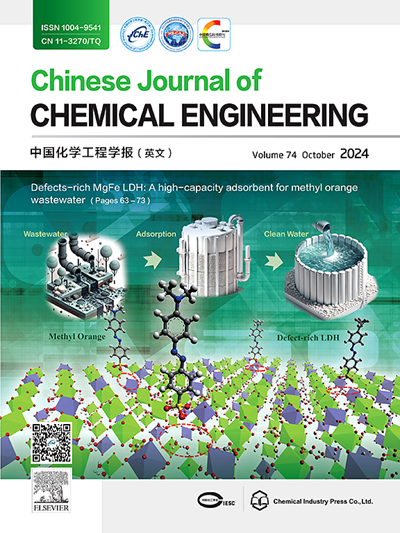活化剂作用下污泥热解气态产物及活性炭的表征
IF 3.7
3区 工程技术
Q2 ENGINEERING, CHEMICAL
引用次数: 0
摘要
在固定床反应器中,对污水污泥(SS)和浸渍了活化剂(ZnCl2和KOH)的SS进行了热解,得到了气态燃料和活性碳。系统研究了加热速率、热解温度和活化剂类型对活性炭产气量、孔隙结构和吸附性能的影响。结果表明,热解温度从450℃升高到850℃,SS快速热解的H2和CO产率成比例增加,而CH4产率在650℃至850℃之间变化最小。ZnCl2显著提高了CO产率,850℃时达到71.9 ml·g−1,但在实验条件下CH4产率明显降低。同样,在750°C和850°C时,KOH促进了CO的产率,对CH4的产率影响最小。两种活化剂在450 ~ 550℃范围内H2产率均较高,850℃无活化剂时H2产率最高(109.8 ml·g−1)。在450 ~ 850℃的热解温度下,zncl2辅助热解得到的活性炭具有发育良好的微孔和中孔结构,比表面积在188.2 ~ 54.1 m2·g−1之间。作为亚甲基蓝的吸附剂,活性炭具有更大的比表面积和总孔容,表现出更强的吸附能力。拟二级动力学模型很好地描述了吸附过程。本文章由计算机程序翻译,如有差异,请以英文原文为准。
Characterization of gaseous products and activated chars from pyrolysis of sewage sludge in the presence of activating agent
Sewage sludge (SS) and SS impregnated with activating agents (ZnCl2 and KOH) were pyrolyzed in a fixed-bed reactor to produce gaseous fuel and activated char. The effects of heating rate, pyrolysis temperature and activator type on gas yields, pore structure and adsorption properties of activated char were systematically studied. The results demonstrated that increasing the pyrolysis temperature from 450 °C to 850 °C proportionally enhanced H2 and CO yields from the rapid pyrolysis of SS, while CH4 yield showed minimal variation between 650 °C and 850 °C. ZnCl2 notably increased the CO yield, reaching 71.9 ml·g−1 at 850 °C, but caused a marked reduction in CH4 yield under the tested conditions. Similarly, KOH promoted CO yield at 750 °C and 850 °C, with minimal impact on CH4 production. Both activators facilitated higher H2 yields in the range of 450–550 °C, while the maximum H2 yield (109.8 ml·g−1) was observed at 850 °C in the absence of activator. The activated char derived from ZnCl2-assisted pyrolysis exhibited well-developed micro- and mesopore structures, with specific surface areas ranging from 188.2 to 54.1 m2·g−1 across pyrolysis temperatures of 450–850 °C. When evaluated as adsorbents for methylene blue removal, activated char with greater specific surface area and total pore volume exhibited superior adsorption capacity. The adsorption process was well-described by the pseudo-second-order kinetic model.
求助全文
通过发布文献求助,成功后即可免费获取论文全文。
去求助
来源期刊

Chinese Journal of Chemical Engineering
工程技术-工程:化工
CiteScore
6.60
自引率
5.30%
发文量
4309
审稿时长
31 days
期刊介绍:
The Chinese Journal of Chemical Engineering (Monthly, started in 1982) is the official journal of the Chemical Industry and Engineering Society of China and published by the Chemical Industry Press Co. Ltd. The aim of the journal is to develop the international exchange of scientific and technical information in the field of chemical engineering. It publishes original research papers that cover the major advancements and achievements in chemical engineering in China as well as some articles from overseas contributors.
The topics of journal include chemical engineering, chemical technology, biochemical engineering, energy and environmental engineering and other relevant fields. Papers are published on the basis of their relevance to theoretical research, practical application or potential uses in the industry as Research Papers, Communications, Reviews and Perspectives. Prominent domestic and overseas chemical experts and scholars have been invited to form an International Advisory Board and the Editorial Committee. It enjoys recognition among Chinese academia and industry as a reliable source of information of what is going on in chemical engineering research, both domestic and abroad.
 求助内容:
求助内容: 应助结果提醒方式:
应助结果提醒方式:


